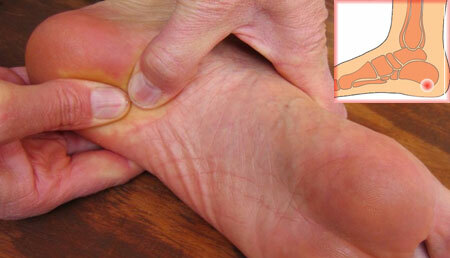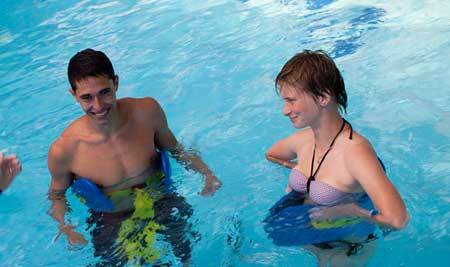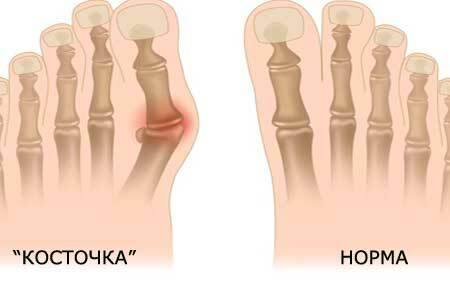Pain in the heel can be caused by various causes, and one of them is the development of the calcaneal spur, or plantar fasciitis. The disease is accompanied by a proliferation of bone tissue and inflammation.
The pain appears due to the permanent traumatization of the tissues surrounding the bone. The factors that provoke the formation of the calcaneal spur, symptoms and treatment of fasciitis are described below.
What is this disease?
Heel spur is the proliferation of bone tissue in the form of a spine in the area of the hump bone of the heel or near the Achilles tendon. Most pathology is detected in middle-aged and elderly people, and in women the predisposition is higher.
 The fascia of the sole( tendon plate - aponeurosis) is attached to metatarsal bones and calcaneal tubercle, providing support for the arch of the foot. When a person is standing, the pressure of half the weight of the whole body is applied to it, while the tissues in the attachment area of the aponeurosis experience the maximum load.
The fascia of the sole( tendon plate - aponeurosis) is attached to metatarsal bones and calcaneal tubercle, providing support for the arch of the foot. When a person is standing, the pressure of half the weight of the whole body is applied to it, while the tissues in the attachment area of the aponeurosis experience the maximum load.
Over time, there may appear microdamages, which usually regenerate themselves. But a constant load and a number of other factors lead to inflammation and pain in the heel, against this background, bony marginal outgrowths or osteophytes form, and heel spurs develop.
Causes of calcaneal spur:
- flat feet and other factors that increase the load on the heel, for example, intense exercise;
- age-related bone changes;
- is overweight;Trauma of the foot and their complications;
- damage to nerve fibers;
- rheumatism;
- of leg vessel disease;
- gout;
- arthritis.
Contents of
- 1
- 2 heel spurts
- 3
-
- 4
-
- 4

The basic symptom of the heel spur is severe pain when walking and any pressure on the heel. It is caused by the influence of bone growth on the adjacent tissues. The severity of pain depends not so much on the size of the growth as on its location.
The closer the spur to the nerve endings, the more painful it is, even with small outgrowths.
In the first stages of pain occurs when walking and pressure on the heel, and subsequently occurs and without any impact on the affected area. This is due to the fact that as the disease progresses in the injured tissues, which are partially scarred, insoluble calcium salts accumulate. They irritate tissues and provoke or intensify the inflammatory process in them.
At the initial stage of the calcaneal spur, the pain arises sharply when supported by the heel, and is especially strong in the morning after lifting or after any prolonged motionless rest.
This symptom is called the starting pain, which, when walking for a day, subsides a little, and in the evening, as a result of prolonged exercise and accumulation of fatigue, increases again.
Because of painful sensations the gait changes - when walking a person tries to lean on his heel involuntarily so as to reduce the intensity of pain. The center of gravity is most often shifted to the edge of the foot, because of which lateral flatfoot develops over time. Especially noticeably the gait changes if the heel spurs are present on both legs.
Heel pain is not always a sign of fasciitis and can occur in the case of Reiter's syndrome, rheumatoid arthritis and Bekhterev's disease. Therefore it is important to visit an orthopedist, surgeon, rheumatologist and undergo a complete examination. To make an accurate diagnosis, laboratory tests of blood and urine, an X-ray of the foot and ultrasound examination are possible.
Treating the calcaneal spur - drugs and techniques

The choice of means for treating the heel spur is determined by the stage of the lesion. The following can be used:
- drug therapy;
- physiotherapy;
- surgical intervention;
- auxiliary means of traditional medicine.
Medications
Drugs for calcaneal spurs:
- NSAIDs - orally, by injection or by phonophoresis( Ibuprofen, Diclofenac, Ketoprofen).
- Local anti-inflammatory drugs - gels, patches, creams, ointments. They can be both non-steroidal anti-inflammatory and hormonal( Hydrocortisone, Indomethacin, Diclofenac, Voltaren).
- Local anesthetics are indicated for the relief of pain, or the so-called blockade of the calcaneal spur( Novocaine, Betamethasone).From the glucocorticoids, Diprospan is also used for this purpose - it is injected once into the affected area.
Physiotherapy
In addition to curative gymnastics and massage to reduce pain and improve the movement of blood and lymph in the foot, such physiotherapy procedures help:
- UV irradiation;
- electrophoresis with potassium iodide or Novocain;
- magnetotherapy;
- therapy with electric field of high frequencies( UHF-treatment);
- therapeutic foot bath.
Special orthopedic insoles should also be used regularly. With a calcaneal spur, they fix the foot, and the heel is in a slightly elevated position, which reduces the intensity of pain.
Surgical intervention
Indications for surgery include ineffectiveness of drug treatment and severe pain. Surgical treatment gives a 100% result, but spurs are resorted to in the most extreme cases.
Most heel spurs successfully treated without surgery.
Treating the calcaneal spur at home
Various methods are used to treat the calcaneal spur at home, but they should not be replaced by drug therapy prescribed by the doctor. As additional tools are effective the following:
- Warming the heel with bischofite solution, which you need to moisten gauze, apply it at night and remove in the morning, thoroughly washing off the remnants of the compress. The course is 10-15 procedures.
- Hot baths with sea or table salt at the rate of 3 tbsp.l.per liter of water. The procedure is performed daily at bedtime for 25-30 minutes. You can not wash your feet afterwards, wipe your skin dry and wear terry or woolen socks all night long.
- Iodine with calcaneal spur is also effective. To treat morning and evening on the heel, you need to apply an iodine mesh. It is also useful to make hot baths with iodine and baking soda.
- You can apply a compress with medical bilge before bedtime. The agent lubricates the heel and closes it with food film. The course is held until there is relief.
- For three weeks, you can make a gauze compress with a mixture of powder mummies( 2 tablets), tinctures of saber( 4 tsp) and pork or goose fat( 1/2 tbsp.).Ointment is applied every day for 3-4 hours.
In the popular treatment of the calcaneal spur, balm with a golden mustache, baths with turpentine( 3 tablespoons per 5 liters of water) or a decoction of herbs such as wormwood, marshmallow, nettle and burdock taken in equal parts( 2 tbsp.l mixture to 2 liters of water).
Forecast
With a calcaneal spur, the prognosis is favorable if the treatment is started on time and is prescribed by a specialist. Long-term development of fasciitis not only brings tangible discomfort and pain to everyday life, sometimes with the need to comply with bed rest for up to 3-4 months and longer, but also fraught with complications such as damage to nerve fibers, decreased mobility, osteophythmic spalling.
Preventative measures
Prevention of calcaneal spur is as follows:
- fight against excess weight and an active lifestyle;
- avoid excessive load on the feet;
- timely treatment of spine and joint pathology;
- prophylaxis of flatfoot, and with its presence wearing orthopedic insoles and shoes;
- the reference to the expert at the first suspicions on a heel spur.



